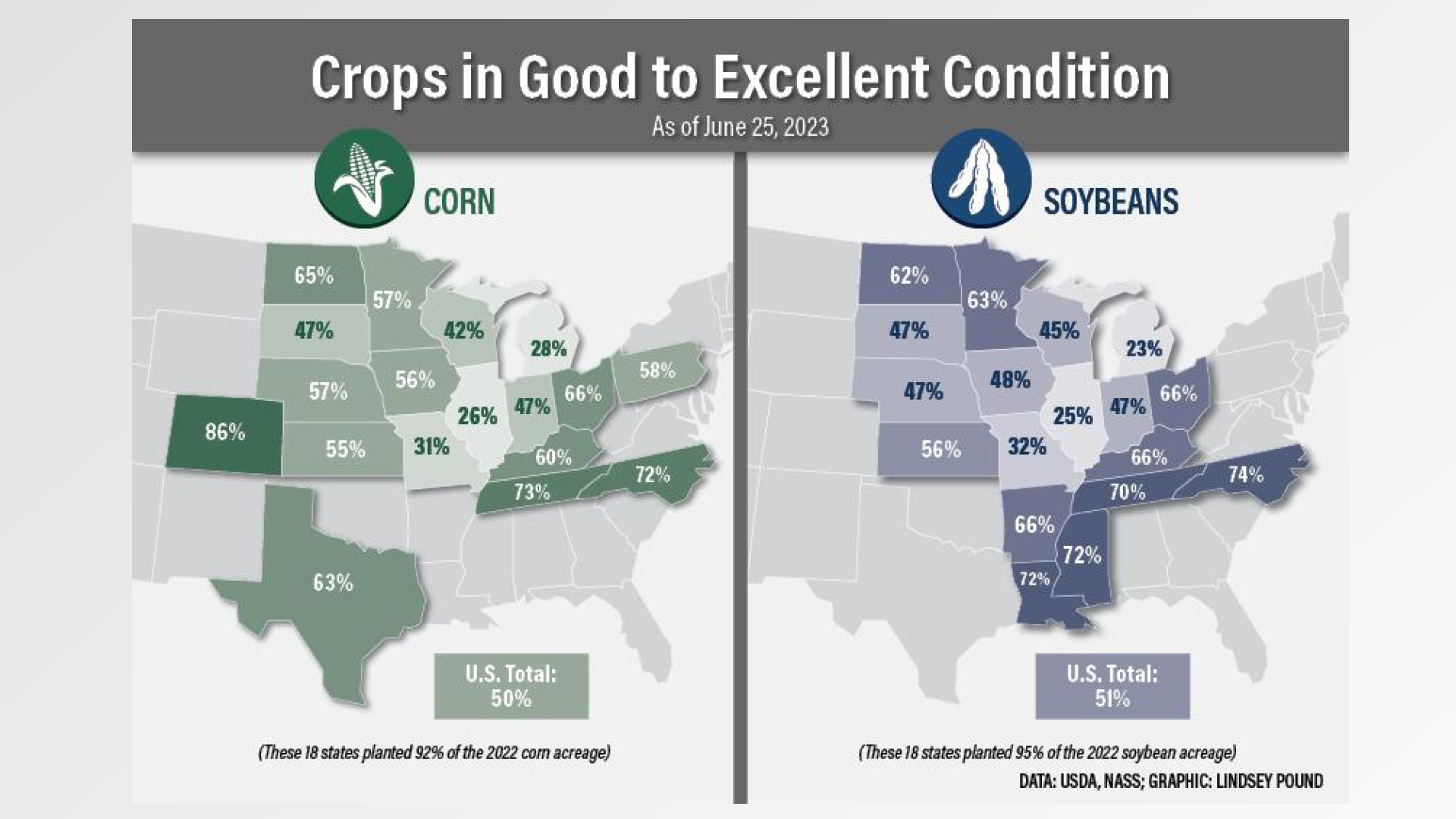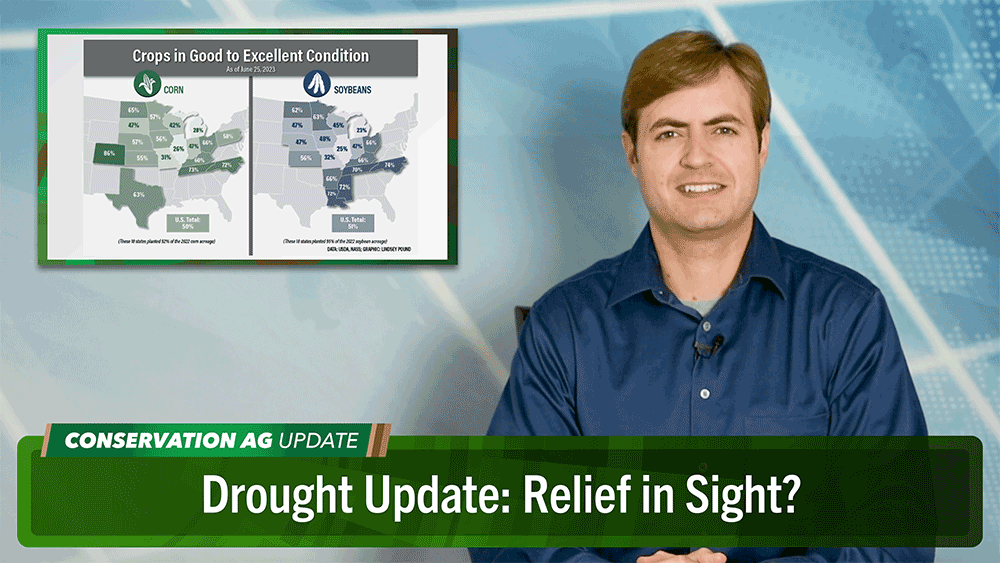In this episode of Conservation Ag Update, University of Illinois ag professor Gary Schnitkey has the latest on drought conditions and explains why there’s still hope for above average yields. Plus, we take a trip back to 1988, when President Ronald Reagan visited drought-stricken Illinois.
In the Cover Crop Connection segment, Brendon Blank of Byron Seeds introduces us to a versatile cover crop mix known as Maize Pro.
Also in the episode, Bay City, Mich., no-tiller John Burk uses cover crops to fight a major pest, soil health expert Jamie Patton checks in from a soil pit to show how no-till is transforming a Wisconsin farm after several years of conventional tillage, cutting-edge technologies debut at the Linco-Precision Field Day and the LaserWeeder zaps weeds in our video of the week.
This episode of Conservation Ag Update is brought to you by Yokohama Off-Highway Tires
VF tires are constructed with sidewalls that enable them to bear heavier loads and operate at lower inflation pressures than traditional radial tires. In fact, VF tires, like our Alliance AgriFlex+ range, can carry up to 40% more load than a conventional radial tire at the same inflation pressure or operate at up to 40% lower air pressure under the same load. VF tires offer quantifiable improvements on the farm. For example, the ability to carry heavier loads can cut down significantly on fuel use and reduce machine hours, while the ability to operate at lower inflation pressures allows tires to produce larger footprints, which can improve traction and reduce soil compaction. The best part is, you can choose which benefit works best for your operation Learn More at https://yokohama-oht.com
TRANSCRIPT
Jump to a section or scroll for the full episode...
- Drought Update: Corn & Soybean Conditions Worsen
- Lessons Learned from 1988 Drought
- Derecho Flattens Midwest Corn Fields
- 10+ Species Cover Crop Mix for Intensive Maize Crop Rotations
- Michigan Farmer Controls Cyst Nematodes with Cover Crops
- 3 Years of No-Till Transforms Wisconsin Farm
- Cutting-Edge Technologies on Display at Linco-Precision Field Day
- Video of the Week: LaserWeeder in Action
Drought Update: Corn & Soybean Conditions Worsen
The drought is once again the big story, as dry conditions continue to cause problems across much of the U.S.
Despite some much-needed rain throughout parts of the Corn Belt and other regions, corn and soybean conditions at the end of June were the worst since 1988, as illustrated by this AgWeb graphic.

According to the USDA, only 50% of corn and 51% of soybeans are considered in good to excellent condition. But is there relief in sight? Maybe, says Gary Schnitkey of Farmdoc Daily at the University of Illinois.
“We don’t know that at this point in time, and any rains that may occur between now and mid-July may alleviate much of that drought. For example, we had a lot of dry conditions in 2000, but that year we also had above trend yield. If we look moving forward though, however, at this point in time there isn’t much call for rain and if we look at conditions moving forward, many people including USDA are suggesting that drought may persist and perhaps intensify in much of northern and central Illinois.”
Lessons Learned from 1988 Drought
Some no-tillers are growing concerned that this year could turn out as dry as 1988, which was the worst drought year since the Dust Bowl.
It was especially bad in Illinois that year, prompting a visit from President Ronald Reagan to drought-stricken areas in the state. We have an article on No-TillFarmer.com featuring 10 lessons learned from 1988 that can help lessen crop risk from an early season drought. Check out the article to see how certain management practices can help you beat the drought.
Derecho Flattens Midwest Corn Fields
Some farmers in the Corn Belt are also in clean-up mode now, after an intense line of thunderstorms known as a derecho ripped through the central U.S. last week.
 Courtesy: @ilcorn
Courtesy: @ilcorn
Here’s a look at some of the damage caused by 100 mph wind gusts in central Illinois. New Berlin farmer Marty Marr holding up a corn stalk after his field was flattened by the derecho June 29. AccuWeather Senior Commodity Meteorologist Dale Mohler says some of this corn is likely to recover and produce a normal yield. But some fields may not recover, and there will no doubt be some crop loss.
10+ Species Cover Crop Mix for Intensive Maize Crop Rotations
At a recent Jefferson County, Wisconsin, field day, Brendan Blank of Byron Seeds talked about a versatile cover crop mix known as Maize Pro that is literally growing in popularity. Designed for planting around August, it is meant to overwinter and come through in the spring. Let’s take a closer look at what’s in this mix.
It's got a quite a variety of stuff in it. Some summer annuals that winter kill, it's got some of the radishes. It's some flax, some Cecilia, a lot of stuff that winter kills, but also a lot of stuff that over winters, we got the hairy vetch here, we got some crimson clover, a number of different clovers. But it's been a really, really popular mix.
Really like the balance of it. It gives a really good growth in the fall with some of the warm season stuff as well as the cool season stuff once those fall off. So all the different growing seasons that we encounter from August through October and end into November and then starting again in the spring, it's really got something that really maximizes all those. There's a lot of variety in it and one of the neat things that's just kind of been fun with it is it's got such a good balance to it.
You can pretty much go out there and find every single species that's, that that's within it. A lot of times you get a cover crop mix and they can be hard to find everything that you had in there. And that's been fun with this one. It's just been a really solid mix for us that's been, been growing in popularity.
Brendan also noted that it’s so versatile, that whether it’s a dry environment, a wet environment, planted late vs. planted early, it can adapt quite well to lots of different seasons and environments.
Farmer Feature: John Burk, Bay City, Mich.
Bay City, Mich., farmer John Burk started planting cover crops 20 years ago to fight a major pest.
Cyst nematodes were wreaking havoc on his sugar beets. So, he planted radishes, and their allelopathic effect have all but eliminated the problem. They’ve also helped with compaction, which was another major issue caused by the size of sugar beet roots. Now, John uses up to 5 different species of cover crops at a time. As he shows us here, winter peas have shot to the top of his power rankings for their ability to fix nitrogen.
“More for the nitrogen benefit to help the radishes grow a little better. When they overwinter, we get these nice little nitrogen nodules, and we get quite a bit of nitrogen credit out of these peas. These are Austrian winter peas where typically they’ll freeze out over winter, but we’ve had such mild winters they overwinter and start growing for us.”
“Some people are watching this, looking for advice and tips for success when it comes to cover crops — what’s some of the wisdom you’d share in that department?”
“If you’re going to do cereal rye, which is a great cover crop, I like it, once it’s knee to waist high, the roots are down around 42 inches, that’s the deepest a rye root will go. It’s time to terminate it, it doesn’t need to grow anymore. The only problem with cereal rye this time of year, if it rains tonight, that stuff will go from being 6 inches high to waist high over night. You need to be on the ball when terminating rye. We had 1,000 acres one year, it was a wet, warm spring, that wasn’t a fun year trying to keep up with the rye. But we managed and we had beautiful soybeans. Sometimes you have to make tracks in the field trying to kill that stuff, but that soil is really forgiving when you have that much organic matter and that rye mixed into the soil.”
For first-time cover croppers, Burk recommends not being too aggressive — starting small or trying something that winterkills.
Soil Pit Shows 3-Year Impact of No-Till & Cover Crops on Compaction
Farmers in southeastern Wisconsin got an up-close look at the power of cover crops and no-till at the Jefferson County Soil Builders Field Day.
Soil health expert Jamie Patton…digging deep into a field that recently transitioned to no-till and cover crops after decades of conventional tillage. Patton shows our Michaela Paukner how these conservation practices are transforming the soil after just 3 years.
“We see some of this structure here at the soil surface. As I break this out, we notice it’s a large chunk and we don’t have very good aggregation. We’ll see that continue down the soil profile. This farmer has been no-tilling 3 years now. What I like to point out is how beautiful the roots are starting to fill in these aggregates. When we look at these roots, we can see this cover crop which is a multi-species mix. We’ll notice the roots are getting down through here. I want to point out that even though this compaction is occurring, when I start to crumble it apart, what those roots are doing is helping to break that structure apart. I’m having no difficulties breaking this into smaller aggregates. That’s what the roots are doing for this soil. They’re helping to recreate those aggregates, pore space and tilth that makes this a healthy soil.”
Cutting-Edge Technologies on Display at Linco-Precision Field Day
5 new technologies that may be of interest to no-tillers and strip-tillers were on display at the Linco-Precision Field Day.
Greeneye, Augmenta, Farmwave, Leaftech and Sabanto showcased their cutting-edge technologies. Check out PrecisionFarmingDealer.com for an in-depth look at each of these products and their potential benefits in a no-till/strip-till system. We featured Leaftech’s handheld tissue analysis tool in the premiere episode of Conversation Ag Update — Linco-Precision owner Skip Klinefelter says it’s one of the products generating a lot of interest right now.
“The hottest thing as far as interest is the autonomous tractor, but I think that’s going to be the slower adoption just because it’s such a leap for people. But the Farmwave system here on my combine you can show a good ROI on that, and it’s less expensive to begin with. The Leaftech system, especially for retailers or multiple large farmers, those are no-brainers if you do the ROI on them. And we calculate that, we sit down with people, I don’t recommend a 500-acre farmer to rent a Leaftech system, because he’s going to do it himself. Although there could be some payback there. We have a couple larger farmers here, and there’s a large farm group here looking at renting them and sharing them amongst themselves.”
Video of the Week: LaserWeeder in Action
Have you heard of the LaserWeeder? It’s a machine from a company called Carbon Robotics that uses AI and laser technology to zap weeds.
Our video of the week shows it *laser weeding* in densely planted chard. CEO Paul Mikesell says the LaserWeeder pays for itself within 3 years, with an 80% reduction in weed control bills — a number that comes from a couple different growers on the West Coast. LaserWeeders will be making their way to the East Coast and Canada in 2024.
Have an interesting photo or video from your farm? Or a story you’d like us to feature on the broadcast? Send me an email at Nnewman@lesspub.com.
And that will wrap things up this edition of Conservation Ag Update. Until next time, for more stories visit no-tillfarmer.com, striptillfarmer.com and covercropstrategies.com. Thanks for stopping by. Have a great day!








